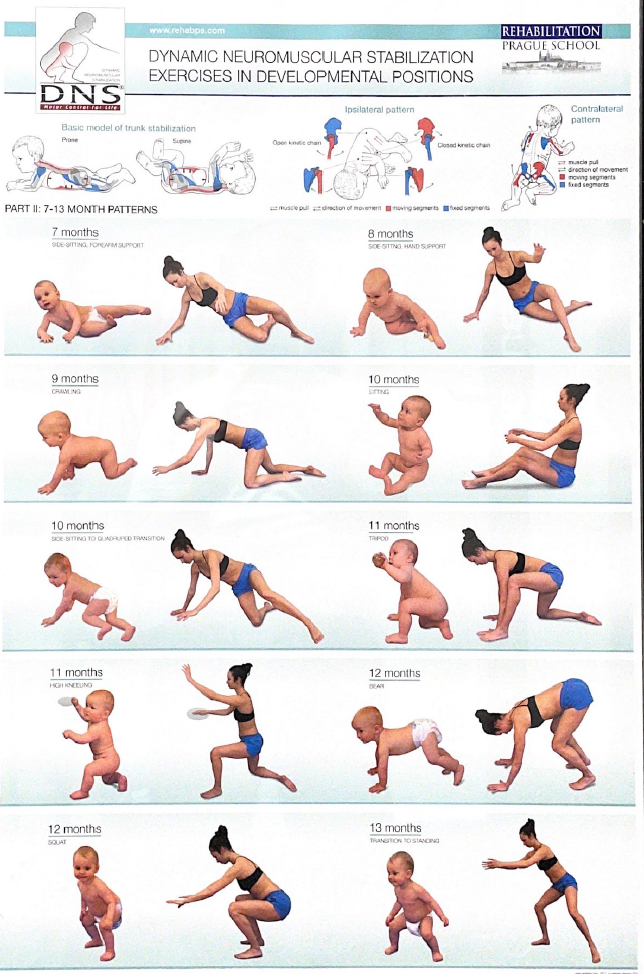

Human Movement and Develpment
When it comes to human movement, there’s no better blueprint than watching how babies develop. From learning to lift their heads to crawling and standing, each movement milestone reflects deep neurological programming that sets the stage for lifelong stability, coordination, and movement quality. This is the foundation of developmental kinesiology—and it’s exactly what Dynamic Neuromuscular Stabilization (DNS) is built upon.
What Is DNS?
Dynamic Neuromuscular Stabilization (DNS) is a rehabilitation and movement strategy developed by Professor Pavel Kolář and the Prague School of Rehabilitation. It’s a science-backed system that uses the principles of developmental kinesiology to assess and treat movement disorders across all ages.
Rather than just focusing on isolated muscle strength or flexibility, DNS looks at the neurodevelopmental patterns that form in the first year of life—the exact patterns babies follow to achieve ideal posture, stabilization, and functional movement.
Why Developmental Milestones Are So Important
During the first 14-16 months of life, a child progresses through specific motor patterns: lifting the head, rolling over, sitting, crawling, and walking. These patterns are not random—they’re hardwired sequences that build core stability, joint centration, and postural control.
Failure to hit or integrate these milestones properly can result in lasting movement dysfunction. In fact, many adult movement limitations can be traced back to unresolved developmental issues. DNS helps to “reboot” these foundational patterns and restore functional movement.


A Few Key Concepts from Developmental Kinesiology:
Ideal stabilization precedes movement – The body must learn how to stabilize (via the core and diaphragm) before performing purposeful actions like reaching or stepping.
Joint centration – Joints need to be optimally aligned during movement to avoid excessive strain and allow for efficient force transfer.
Feedforward activation – Deep stabilizers (diaphragm, multifidi, pelvic floor, deep neck flexors) engage before movement begins, providing a stable base.
Sensorimotor integration – All movement requires seamless coordination between the nervous system and the musculoskeletal system.
How DNS Applies in Therapy (Even for Infants)
DNS doesn’t just describe what’s supposed to happen—it’s also a therapeutic approach that helps patients (including infants) relearn or refine motor patterns.
For pediatric patients, therapists may guide a baby through ontogenetic positions (positions babies naturally move through in their development) to promote healthy spinal alignment, breathing mechanics, and muscle coordination. These DNS-based rehab sessions are especially useful for:
Children with developmental delays
Infants showing asymmetry or poor postural control
Babies with hypotonia, cerebral palsy, or torticollis
Each session may include:
Positioning the baby into age-appropriate developmental postures (e.g., 3-month supine position)
Encouraging specific movements like reaching or rolling
Supporting diaphragmatic breathing and spinal stabilization
The Long-Term Impact
By restoring the “software” of movement rather than just treating isolated symptoms, DNS offers a powerful strategy to improve outcomes in both children and adults. It builds a stronger foundation for:
Postural control
Breathing mechanics
Functional movement
Injury prevention
Whether you’re a parent concerned about your child’s development or a clinician seeking more holistic rehab strategies, DNS offers a practical, proven framework rooted in how we’re wired to move.
Next Steps: Supporting Your Child’s Movement Development
If you’re concerned that your baby is not hitting their movement milestones or you’ve noticed asymmetry, delayed motor control, or unusual posture, it’s worth seeking out a trained professional. A practitioner trained in DNS can help assess your baby’s development and guide you through individualized rehab strategies to support healthy movement.
One of the greatest strengths of DNS is that much of the work can be done at home with your baby, using purposeful positioning and play. You’ll learn how to:
Support proper motor patterns during daily activities
Encourage optimal breathing and core control
Integrate neurologically driven movement strategies into your baby’s routine
To find a qualified provider, search “Dynamic Neuromuscular Stabilization practitioner near me” or use the official DNS provider directory to locate someone in your area.
If you’re in the Metro Detroit area, I highly recommend scheduling an appointment with my colleague, Dr. Sheridan Kent.
Early intervention makes a difference. The sooner you address these developmental concerns, the better your child’s chances of growing up with strong, coordinated, pain-free movement for life.




